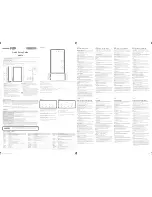
67
Color
An image mode that scans an image as red, green and blue (RGB) light and can
reproduce each one of these three colors in 256 distinct tones (8 bits). Since
256 x 256 x 256 = approximately 16.7 million, this many color tones are
possible in this mode.
ColorSync
A color management system for Macintosh computers. Automatically
compensates for color differences between scanners, monitors and printers.
ColorSync requires that a color profile file be included for your specific monitor
or printer.
Contrast
The difference between light and dark areas of a scanned image. Raising the
contrast makes individual components of an image stand out more while
lowering it softens the image’s overall appearance.
Dot
The basic element used to reproduce images. Images are reproduced as
columns and rows of dots. A scanner’s resolution is the measure of the number
of dots it can read and reproduce per inch (dpi).
DPI
Dots per inch. An expression of monitor and printer resolution. Measured as the
number of dots per horizontal inch on monitors and the number of dots that
can be printed by a printer in an inch. See also Pixel, Optical Resolution and
Resolution.
Gamma Value
A function for adjusting the overall brightness of an image. A gamma value is
the mathematical expression of how brightness data is converted from a
scanner (the input) to a monitor or printer (the output). With 1 as the base
value, a gamma value less than 1 makes an image darker, while a higher value
makes it brighter. The brightness handling characteristics of monitors vary
between manufacturers and models. A monitor’s gamma value explains the
degree to which its output (what you see on the screen) varies from the input
value.







































